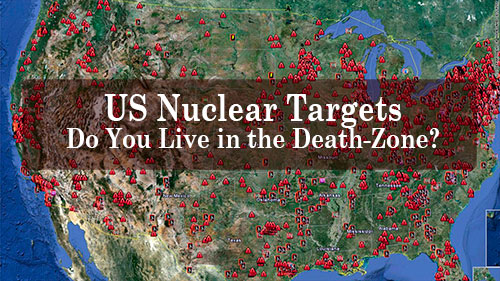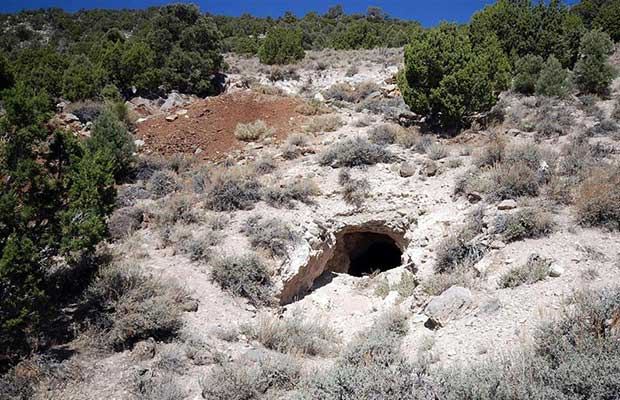
What lured the early settlers and adventure seekers to the vast territory of the American West? In a word: Gold. Early exploitation of minerals and ores were greatly hampered by the lack of economical milling and transportation resources. Unprocessed ore was frequently transported overland in pack trains to seaport locations like San Francisco. From there, the ore might have been shipped around the horn to a mill on the east coast. As the railroad system expanded in the 1870’s and beyond, the extraction of less valuable metals, such as silver, copper and manganese became more viable endeavors. Eastern industrialists and speculators became more willing to invest in prospects – often without proper due diligence. Mining activity exploded and, as a result, there are many thousands of abandoned mines in the West and Southwest today.
How could that bit of history factor into your planning and preparation if you have to deal with a SHTF scenario? Let’s say you made the decision to shelter in place, but now your regional or area security has deteriorated, and you need to move yourself or family to a safer location; if only for a few days or weeks? What if you don’t have that ideal piece of land in the mountains with a lake or trout stream to retreat to? You have an exigent need to abandon your preferred location because it is about to be compromised.
The answer could be a specific type of mine structure known as an adit.
Within a one hour driving radius of my home there are more than four hundred abandoned hard rock mines. That may seem like a startling statistic, but historical records indicate that my state has more than 100,000 mines dating from the 1850’s through the depression era of the 1930’s. Some of these were good producers of ore and have extensive underground workings. Others never got beyond the ‘prospect’ stage of development, yet still managed to establish one or more tunnels, adits, shafts, drifts and/or stopes. Some of them have been destructively collapsed by the BLM in recent time, others are unsafe or possess unsuitable characteristics; but many surviving mines can be used for temporary occupation if you know where they are and have the means to get to them.
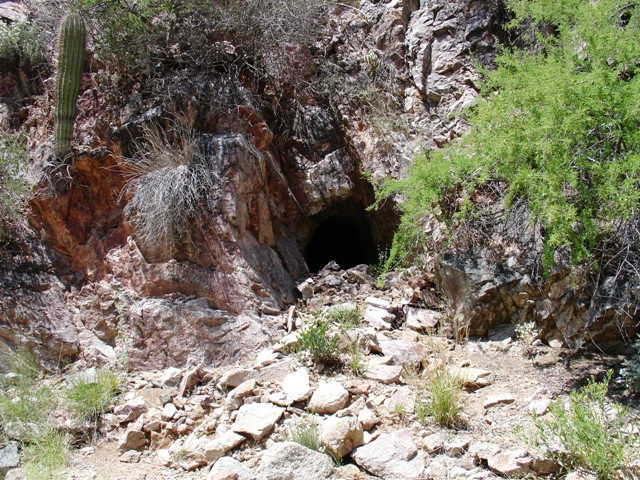
Mine entrances may be elevated on a hillside or at lower levels, near a wash or creek. In this example, the adit is at the base of a steep hill, but is several feet above a wide wash.
A cursory examination of geological survey maps in any western state will give you an appreciation for the number of hard rock mines (named or otherwise) that were developed in the west. Map symbols that denote the location of shafts, adits and tunnels provide only a partial census of mining activity. In other words, the number of mine workings greatly exceeds what you will find on any map or reference site. I should add that older geological survey maps tend to provide better information than ‘newer’ editions.
A Serious Word of Caution:
I would be completely remiss if I did not warn you that abandoned mines should be treated with utmost caution, at all times. If you are like the vast majority of people, you will have no working knowledge of underground mines. Frankly, the act of reckless exploration makes you the primary source of risk to yourself and others. People die in abandoned mines because they were uninformed, ignored indicators that would have been obvious to an experienced individual, or they were reckless thrill seekers.
This article is emphatically not about exploring deep subterranean passages or rappelling down vertical shafts; those are activities that, at best, should be left to experts or avoided entirely. Rather, this article attempts to provide you with an option for the use of a specific mine feature; one that bears no practical risk to the safety of you or your family if you use good judgment.
Stay clear of mines with vertical or incline/decline shaft entrances. Aside from the fact that they are not practical selections for shelter, many shafts are flooded at some depth. Moreover, shafts that have no protective collar at the opening may have loose, slippery material. Mine tunnels and adits frequently have vertical passages in the interior that connect to lower workings. Some of these may be hundreds of feet deep. Some adits may have been purposely collapsed, or the entrance may have been rendered unsafe by the passage of time.
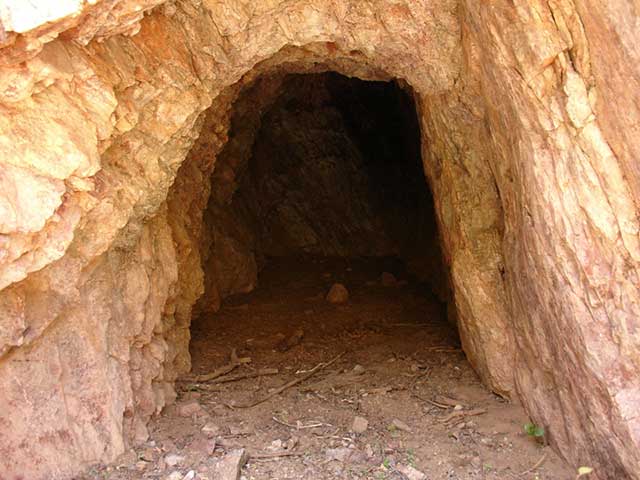
This adit is about 20 feet in length and is located on the margin of a narrow wash. Note the presence of silt on the floor.
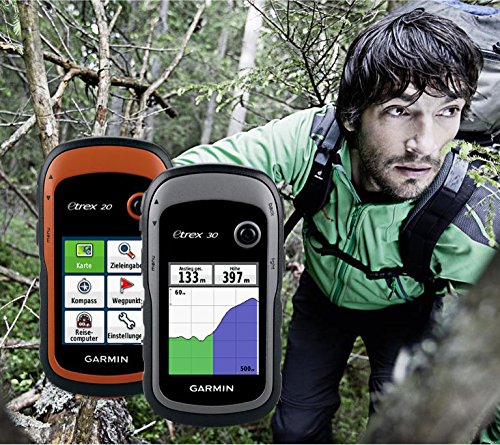
A good GPS unit could help you locate your hidden caches of supplies that you store for a SHTF scenario.
Determining whether a mine is ‘safe’ requires preparatory research, on site investigation and a thoughtful evaluation of its construction and current state, as well as an assessment of the resources that may be locally available. There are mines that I will have no qualms about using because I’ve studied them; but there are many that I would not enter for any conceivable reason. In the final analysis, you must determine whether a mine is safe to use and whether it would meet your temporary security needs. Importantly, you cannot wait until SHTF to begin thinking about the selection of an adit.
Basic Terminology
Listed below are a few important terms used to properly identify pertinent aspects of a mine. These are taken from the American Geological Institute.
- Adit – A horizontal mine passage driven in from the surface. Adits have a single external entrance point, but may connect to other interior mine workings, such as shafts. This is in contrast to a tunnel, which has openings to the surface at each end.
- Country Rock – The ground material around (surrounding) an ore body. In this case, ‘ground’ does not mean dirt. It refers to rock, such as basalt or granite.
- Crosscut – A horizontal underground passage driven perpendicular to the strike of an ore body. A crosscut does not have openings to the surface of the mine.
- Drift – Usually a horizontal underground mine passage driven parallel to the strike of an ore body.
- Dump – Waste rock removed by mining and deposited on the surface.
- Incline/Decline – A mine passage driven from the surface at an upward or downward angle from horizontal.
- Manway – A vertical underground passage with ladder for upward or downward movement of miners. This could be a winze, raise or shaft.
- Muck – Waste rock that is sometimes stacked internally or used to fill stopes.
- Pillar – Usually a column of ore left to support the roof in a stope (or room) or to support the country rock above an ore body.
- Post – A vertical support member (often timber) used to support a cap (often timber) that in turn supports the roof.
- Raise – An underground mine opening driven upward from below to access an overlying ore body or to provide access to an upper level.
- Shaft – A vertical mine passage opening to the surface for removal of waste rock, ore or entry of miners.
- Stope – An underground cavity left by removal of ore above or below a working level.
- Strike – The linear orientation of an ore body relative to the surface. For example, a north-south strike.
- Tailings – The finely crushed material left after a milling operation, not the same as a dump, dump rock or waste rock.
- Tunnel – A horizontal underground mine passage open to the surface at both ends.
- Winze – An underground mine opening driven downward from inside to access an ore body below, or to access a lower level of the mine.
There are many other terms that describe various characteristics of a hard rock mine, but these provide a basic description of features that are relevant to the assessment of a mine.
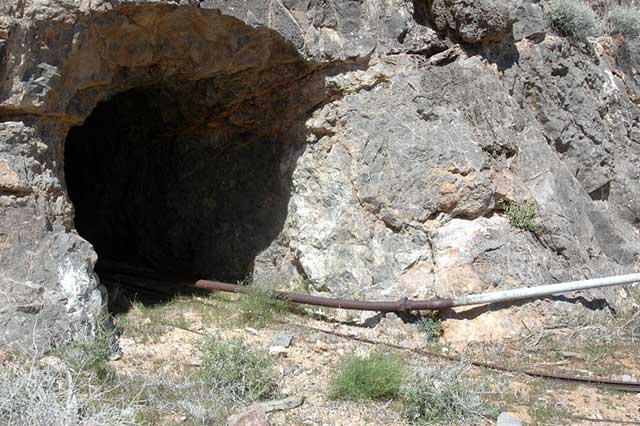
This adit contains an interior shaft with one or more lower levels. The pipe transported water from a sump area to the outside. Note also the ore car rails.
Reasons Why Mine Adits Might Be Considered
We’ve already established that your primary safe site is in jeopardy of being compromised. We can assume that you have no other quickly accessible and secure fall back location. So, what makes certain types of hard rock mines a suitable place of retreat?
A short list of benefits includes:
-
- Adits are horizontal at the point of entry and possess the general characteristic of having a flat floor. There may be rubble that needs to be removed, but the reason it is flat is because it served the needs of the miner. For example, there may have been ore cars that were pulled by mules, a mechanical winch, or engine at one time. Mine scavengers will have removed most rails and ore cars long ago.
- Frequently, the entrances of adits were situated at a point that facilitated the easiest and most economical way to remove waste rock and ore bearing material from interior mine workings, such as shafts and stopes. That means the adit may be located at or near the same level as the operations that occurred outside. Moreover, the adit may have provided a convenient path for laying electrical cables, drainage pipes and air hoses. Because of this, adits may be relatively wide (eight feet or more).
- Adits that date from territorial days are frequently large enough to permit you to stand fully erect. Mines that date to the Spanish colonial era (1500’s to 1700’s) were dug by slave labor and are more likely to be very narrow, cramped passages.
- Many mines in remote areas are still accessible via 2-track or 4WD trails. You might have to hike the last couple of hundred yards, but the mine trail is still there. This means that your vehicle can be kept close to (and in view of) the mine entrance.
- In the mountainous regions of the West, adits are generally located on what I would call “steep ground.” That is, they are on the side of a hill or mountain. Importantly, that means it has some degree of elevation and a defensive field of view.
- The temperature in the interior of an adit is pretty stable. If you are several feet inside the entrance, the temperature may not fluctuate more than a few degrees during a 24 hour period. I have been deep inside some adits where the temperature was quite warm.
- It may be raining or snowing outside, but you will be dry.
- Many hard rock mines have small, lateral ventilation tunnels. These provide a flow of air that moves at a steady rate. If the mine has additional adits, tunnels or shafts, the flow of air will be in the direction of least resistance. This means that you can have cooking or warming fires inside the mine and the smoke will be dispersed away from you. As long as your fires are not at the mine entrance, no one outside would be able to see the light. The airflow would carry and disperse smoke to other surface openings, making it hard to detect (especially at night).
- Successful mines (those that produced ore) generally had an area outside the adit(s) and shafts that accommodated workshops, housing, and a place for dumping waste rock and mine tailings. Although the buildings may be long gone, it means there could be space to set up a bivouac or open air camp (but carefully consider whether you would want that type of exposure).
- Successful mines generally had a reliable source of water. Whether it was a creek-fed well or one powered by a windmill, there will be evidence of it. Just remember that in many areas of the arid southwest, water may be below ground level.
- Contrary to most imaginings, the vast majority of hard rock mines were not very large. In other words, there is a good chance that the adit might not extend into the mountainside more than 100 feet. I’ve visited quite a few prospects that are no more than 40 feet in length. Once the prospector determined there was no economically viable ore vein, he abandoned it. Simple adits (those without additional shafts or interior working levels) are easy to evaluate.
- Even at relatively shallow depths, no one approaching the entrance of an adit will be able to see you. You have the defensive advantage.
- Many abandoned mines in the inter-mountain west are often located on federal or state land that is leased by ranchers for grazing. Cattle need water, so this means that operating wells may be located nearby.
- Some abandoned mines will have scrap material, including pipes, sheet metal, angle iron, nails and timbers that can be used for a variety of purposes.
- Depending on the depth and bearing of the ore body, successful hard rock mines often had more than one adit to reach the ore strike. While one adit might not be satisfactory (or safe) for use, there may be another suitable entrance nearby.
- Adits will sometimes have drifts that branch off in the direction of the strike. Storage or workshop areas may also have been dug into the country rock, providing added space on the same level.
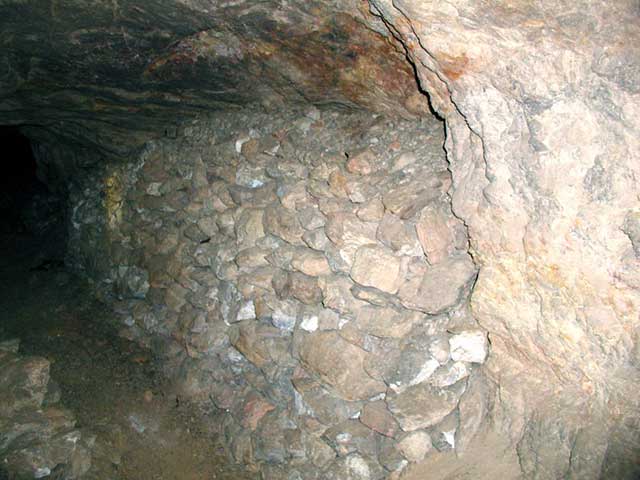
This photo shows an area of the mine where waste rock (muck) was stacked in a stope. It illustrates that interior spaces can be used for storage of supplies, but may require using a portion of the mine that is on a lower level. If it can be reached via a short winze, you may consider using an extending metal ladder. Similar spaces may be available in adits or in drifts that branch off from an adit.
The Downside:
There are a lot of serious reasons to reject a mine site that you might be considering as a potential fall-back location. Here are a few:
- I’ve intensely studied more than 4,000 mines and, as noted, there are more than 400 within a one hour driving radius of my home. My definition of “suitable” and “ideal” may not match yours. There are several locations that I would be willing to use if the need arose, but their selection is based upon my personal knowledge of local terrain, water and game resources, remoteness and accessibility. The point is that you cannot simply select a mine site without having some working knowledge of the surrounding environment. Failure to do so is an invitation to disaster.
- A wet adit floor could mean that interior shafts and lower levels have become entirely filled with water. The mine may have flooded to a point that the water has reached the level of the adit and is now flowing to the outside. It may be possible to set a camp outside of the mine entrance, but your use of the adit is limited to purely defensive (bunker) purposes. This also means that there is probably a flooded shaft somewhere beyond the entrance that you cannot see.
- Many adits have shafts and winzes that lead to lower portions of the mine and some of them can be hundreds of feet deep. If you are contemplating the use of a mine that contains these features, you absolutely must also consider the safety of your family. My earnest recommendation is to keep looking. You might feel comfortable sleeping in front a shaft, but do you want a child anywhere near one?
- There are a variety of wild animals that favor the safety and seclusion of a mine. I once encountered a hibernating black bear in an adit while backpacking in high country wilderness, and I’ve found rattlesnakes in more than one mine entrance. The point is that you may have to clear an adit of wild beasts, even though you didn’t find any the first time that you inspected it. Some mines will provide seasonal or permanent habitats for bats. I am a great fan of bats, but I would avoid mines occupied by them for health reasons.
- Selecting a mine adit that is near a well traveled 2-track road may compromise your security. Remember – other people may also be seeking the shelter and security of a mine. If your objective is safety through seclusion, don’t opt for mines that are situated near frequently travelled roads.
- Adits that contain wet timbers (posts and caps) may indicate water seepage through seams and fractures in the overhead rock.
- Collapsed posts and caps are an indicator that the roof of the adit may be unstable.
- Adits that were dug into highly fractured rock may slough material from overhead.
- Shafts and inclines/declines with ore car tracks and/or ladders constructed from timber should be avoided. These structures could easily be 70 to 150 years old. They may have been well built at the time of construction and they may appear to be in good condition, but no longer possess structural integrity. All it would take is one loose or weak rung on a ladder to send you plunging down a shaft.
- Mines with incline (upward sloping) or decline (downward sloping) entrances have both practical and tactical disadvantages, even if the rate of slope is modest. In such environments, footing is less secure, moving loads into or out of the entrance are more difficult, and your angle of view from within the adit is either pointing toward the sky or down at the ground.
Accessibility
Generally speaking, abandoned mines are located in terrain that is not favorable to the use of towed trailers or motor homes, and many of the mines I have studied are not accessible to passenger cars (including some with all wheel drive) because of low clearance. In other words, you will need high clearance four wheel drive trucks to reach most mines. There are even a few that are best reached by OHV type vehicles, at least within the last mile or so. If you are a “flat-lander”, some of these trails may be intimidating. Heavy storms may lead to rock fall, wash-outs or minor land slides that weren’t there last time you used the trail. When in doubt, it is best to walk the road and clear any debris that might damage your vehicle. Take your time. Be safe.
Roads leading into mining areas may not be maintained by federal or state agencies. In some cases, 2-track roads are only maintained by local ranchers on an as needed basis, even though they are on ‘federal’ land.
Some mines will be located on patented, private land, but that doesn’t necessarily mean that the owner is present. While you are in the scouting and research phase you may want to determine whether the location that you favor is sitting on someone’s private (but otherwise unoccupied) property. In my own research I have located several abandoned mines that are on patented parcels in remote locations. I’ve corresponded with or spoken to some of these land owners and they are all good people. If you establish a fallback site that happens to be on private land, respect their property rights. Do no harm or damage.
Primary all weather roads on National Forests are pretty reliable; however, there is no guarantee that the Forest Service will allow access to forests during a SHTF incident – particularly if martial law has been declared. When you consider that the Forest Service is bent on preventing citizen access to our forests during ‘normal’ times, you would be wise to anticipate complete closure when SHTF. If the intended fall back site requires use of a Forest Service road, I would recommend that you find a ‘back door’ alternate route. If no such route exists, find another mine site.
If you are compelled to use a remote abandoned mine then you are beyond the stage of worrying about brush marks on your vehicle. A lot of mine trails have become overgrown with brush over the decades, which reduces the width of the trail. It will result in some scratches. My advice: Get over it. While we’re on that subject, I would also suggest that you resist the urge to clear the trail. Freshly cut brush and tree limbs are a dead giveaway that someone is using the road. It would be counter productive to leave your calling card where the trail branches off from a frequently traveled 2-track road. At minimum, leave the initial portion of the trail in its native state. You should also consider brushing out any tire tracks that indicate where you turned off.
You may want to consider creating some type of temporary roadblock on the trail leading to the mine site. Vehicles that are already constrained by narrow trails, thick brush or trees will have a more difficult time getting around an obstacle that you have placed on the trail. Anything that impedes or slows down approaching traffic will give you a tactical advantage. Just remember – you will have to clear the roadblock on your way out.
The term “accessibility” can be stretched to include your ability to depart from the fall back site once it is no longer needed. In this context, accessibility implies that you have enough fuel to go both directions. These sites do not come with convenience markets or gas stations, so you will need to bring or pre-position the fuel and supplies needed when you are ready to exfil.
It should go without saying that once you have established your site you should remain in place and limit movement as much as possible. Vehicular movement can be spotted from a distance of several miles when an observer has favorable elevation. The glint from your windshield will alert others to your presence. Button up your site and stay put.
Google Earth can be an invaluable research tool to help you locate and assess the terrain and resources near a mine site.


